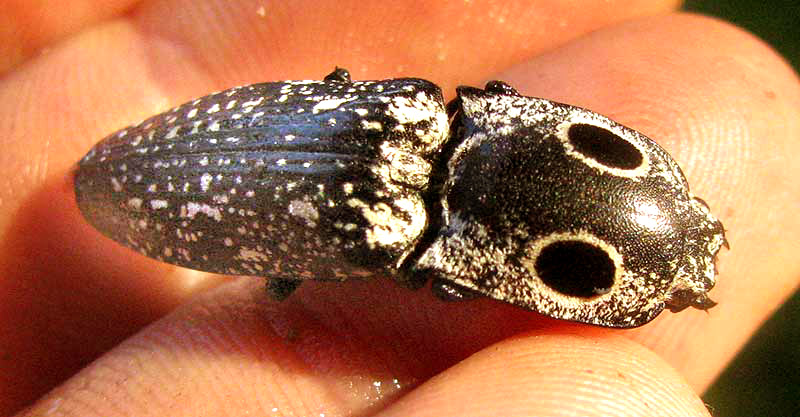Excerpts from Jim Conrad's
Naturalist Newsletter

from the June 17, 2012 Newsletter issued from the woods of the Loess Hill Region a few miles east of Natchez, Mississippi, USA
EYED CLICK BEETLE
Another interesting insect similarly turned up right at my trailer's door, floating in the rainwater tub, struggling to get out. That's the 1¼-inch long (33mm) beetle above.
In general form -- large and slender with parallel sides, and with the base of the bulging front part (pronotum) forming a kind of M where it meets the winged part -- I knew this was a kind of click beetle. As a kid on the Kentucky farm I learned early that if you catch a click beetle the first thing it does is to draw in its legs and antenna, exactly like the one in my hand, and then if between your fingers you hold the bug next to your ear, you can hear and sometimes very definitely feel the beetle clicking. In the picture you can see that the pronotum's rear corners (the M's legs) are prolonged backward into sharp points. These points are clicked against the wing section, and the click can be surprisingly powerful.
The first time one clicked between my fingers I was so surprised that it scared me and I dropped him, half expecting to be stung. That's exactly what the clicking is all about. You can imagine an uninitiated bird's response if such an unexpected clicking occurs just as the beetle is about to be gulped down. Also, most click beetles when placed on their backs can click so violently that they can flip themselves back onto their legs.
The click beetles I grew up with were different species than the one in the picture. In fact the Click Beetle Family, the Elateridae, holds about 9300 species worldwide -- some 965 just in North America -- all capable of clicking.
Bea in Ontario says that our picture shows the Eyed Click Beetle, ALAUS OCULATUS, one of the most common and best known click beetles of eastern North America. Adults mainly deal with reproduction, though they may take some flower nectar and plant juices. Most of the species' life cycle is spent in the larval stage as a longish, slender, honey-colored grub sometimes referred to as a wireworm, during which it preys on grubs of wood-boring beetles.